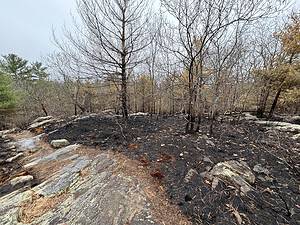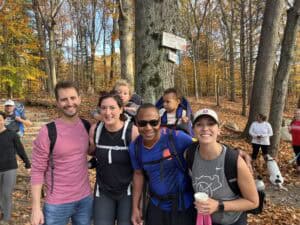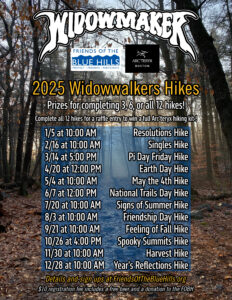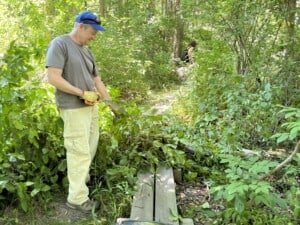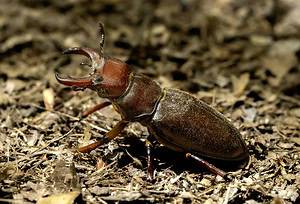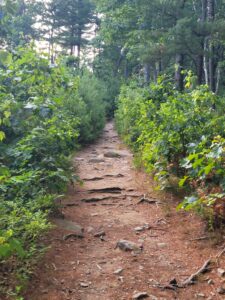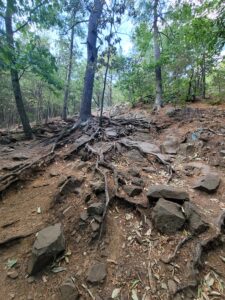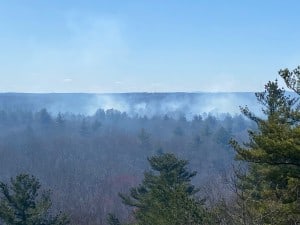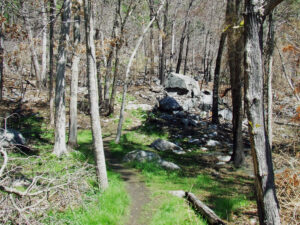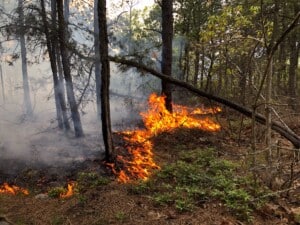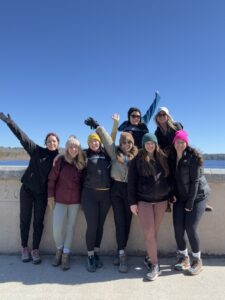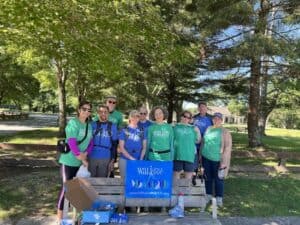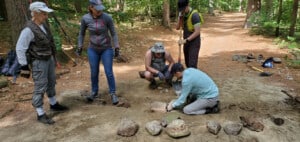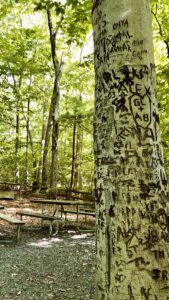Adults and children from Milton, Canton and Quincy climbed Great Blue Hill yesterday to explore butterflies and caterpillars with Sam Jaffe. We all learned why Great Blue is one of the best places to see these beautiful creatures!
To continue exploring the Blue Hills — and seeing great butterflies – check out the resources, events and clubs that Sam suggests. He also noted everything that we saw. So if you couldn’t join us this time, you can look for them on your own!
Friends of Blue Hills Butterfly and Caterpillar Walk
10:00 – 12:30 June 18th 2011
QUICK RESOURCE LIST:
Books:
• Caterpillars of Eastern North America by David Wagner – the only caterpillar book to get. A fantastic natural history guide!
• Butterflies through Binoculars – Full of photographs of butterflies in their natural settings.
• Golden Guide to Butterflies and Moths – They book for kids getting interested… has both butterflies and moths and drawings of many of their caterpillars. My first butterfly book growing up.
Online:
• My caterpillar galleries: www.pbase.com/spjaffe All the more impressive eastern Massachusetts caterpillars.
• BugGuide.com A huge online library of insect images and information. The only way to identify many of the insects we find.
Clubs:
• Massachusetts Butterfly Club: http://www.naba.org/chapters/nabambc/
These guys lead walks and talks and have many great online resources to offer. You don’t have to be a member to join these experts on a field trip.
Events:
• My exhibit and live event at the Boston Children’s Museum this summer “The Caterpillars of Eastern Massachusetts”. Announcement page at www.spjaffe.com
• The Barbara J. Walker Butterfly Festival at Broad Meadow Brook Audubon in Worcester. I’ll be there with caterpillars. Also walks, talks, face painting, food, and more.
BUTTERFLIES
We had great looks at many of these species. However, some were not so cooperative and not everyone had a chance to see them. This was especially true with the skippers. Slow walking and a lo of patience is usually required to see the most butterflies.
Black Swallowtail – We saw many black swallowtails on the hillside and near the weather observatory. These were 100% males, which is not unusual for hill tops, and I have never seen a Black Swallowtail caterpillar up top. Check the gardens and farms at the base of the hill however, and caterpillars can be abundant.
Cabbage White – this is a common backyard butterfly that eats cabbage, broccoli, mustard and others. They were especially common at the base of the hill, but we saw some at the top as well. Get caterpillars by looking on organic veggies and raise them up for a fun and easy project.
Orange Sulphur – Most of the medium sized yellow butterflies were Orange Sulphurs. When they slowed down enough for a good look, rich saturated orange was present on the wings upper surface (the inside).
Clouded Sulphur – I saw at least one clouded sulphur go by. Very similar to orange sulphurs, but without orange tones, among other differences.
Eastern Tailed-Blue – One of the very first butterflies we saw was this delightful little guys… Tiny, blue, with small black spotting, red at the hind wings margin, and a pair of filament like tails. Caterpillars of these are usually abundant in the fall on the flower and seed heads of tall bush clover.
American Copper – We saw at least two of these, one half way up the hill slope and one near the ski lift top. Both were worn, but still pretty in orange and gray. These are closely related to the hairstreak butterflies that I boasted about being reliable great blue hill specialties. Fresh copper butterflies will show up a few more times this season as they go through two or three generations a summer.
Hairstreaks – We struck out on hairstreaks today because the season is lagging this year. However, if you stake out the thistle patch near the weather observatory this July you can see: Coral Hairstreak, Edward’s Hairstreak, Banded Hairstreak, Striped Hairstreak, Oak Hairstreak, Gray Hairstreak, and potentially other rarer species too.
Eastern Comma – Before the walk began proper I released an Eastern Comma that I had raised up – it flew off happily over trailside museum. I also saw a comma or questionmark butterfly flying through the woods, but given their rapid flight, we were unable to look at this butterfly.
American Lady – We saw a number of these, especially as we neared the summit of Great Blue. They are pretty orange, black, and white with slightly rounded wings, and a pair of big eyespots on the outside of their hindwings. They breed on plants that grow in a scrubby patch behind the weather station and their caterpillars should start showing up there within a few more weeks.
Painted Lady – A few of the Ladies we saw were actually this species. These are the same ones schools often raise and release. They have smaller eye spots on the wings and are more angular in shape than American ladies. We also saw their caterpillars being eaten my wasps.
Red Admiral – One red admiral flew by below us as we were climbing the hill. It was a brief appearance.
Red-spotted Purple (Red-spotted Admiral) – We saw one fly by on the hill side and a few more resting on oak leaves around the summit area. We also saw the next generation beginning in the form of their tiny caterpillars eating black cherry leaf tips. In higher elevations and farther north this same species occurs with a bright white band on its wing and is called a White Admiral.
Common Ringlet – A few ringlets were wandering the grassy slopes. They can be abundant some years, but seem rather scarce so far this season.
Silver-spotted Skipper – Pretty much the first butterfly we saw was this large and colorful skipper nectaring on the purple vetch flowers. Their caterpillars build leaf huts in various legumes like black locust and ground nut and have crazy bright orange eye spots on their heads.
Southern Cloudywing – We saw a good number of these large dark skippers on our walk up to the summit. Not easy to find in eastern Massachusetts… Great Blue Hill is the place to look!
Juvenal’s Duskywing – One very worn one along the gravel summit trails. This butterfly is abundant earlier in the year, but their season has almost past.

